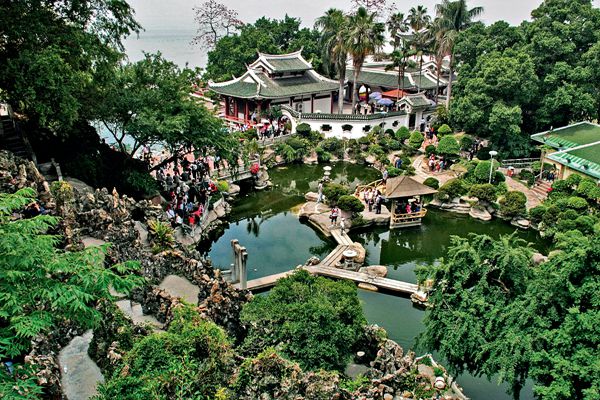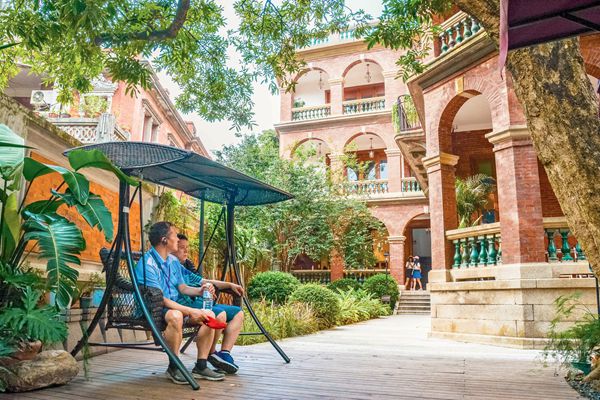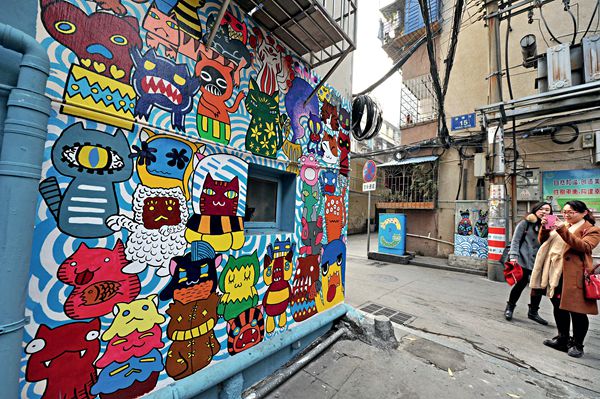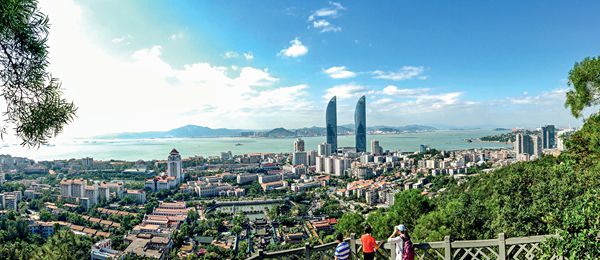XIAMEN, a sub-provincial city in southeastern Fujian, is one of the first Special Economic Zones in China. The city center is actually an island, known as Egret Island. Xiamen has long been an important port city for commerce and trade, across the strait from Taiwan. It has become one of the most important economic and cultural cities on China’s southeast coast, and along with Quanzhou and Zhangzhou forms the “Hokkien Golden Triangle.”
Xiamen is a famous tourist destination because of the city’s beautiful environment combined with the unique culture of southern Fujian. Young people are particularly attracted by the gorgeous coastline and Gulangyu Island, which is known for its colonial architecture. For many Chinese tourists Xiamen is the number one romantic travel destination.
Long History
In Chinese, Xiamen means “the door to the mansion.” Although the history of Xiamen dates back to the third century, it had no administrative significance until 1387 when the first Xiamen City was built. From then on Xiamen was documented in the history books.
Xiamen started to become important in the late Ming and early Qing dynasties (towards the end of the 16th century). Zheng Chenggong was a Ming Dynasty general based on Xiamen port, and he aggressively developed overseas and coastal trade in order to raise money and provisions for his army. After the fall of the Ming Dynasty, Xiamen and Jinmen became important bases for Zheng’s fight against the Qing Dynasty and his efforts to recapture Taiwan from the Dutch colonialists. After the Opium War, Xiamen, together with Guangzhou, Shanghai, Ningbo, and Fuzhou, was forced to become an open trading port and was one of the earliest cities in China to open up trade with the outside world.

Shu Zhuang Garden is the most famous private residence on Gulangyu.
After the People’s Republic of China was founded in 1949, the Kuomintang retreated to Taiwan. In an attempt to enforce the One-China Policy in 1958, exchanges of fire (commonly referred to as the Second Taiwan Strait Crisis) occurred between Xiamen and Jinmen. Afterwards the People’s Liberation Army continued to shell Jinmen regularly until 1979, when a ceasefire was declared. The end of the 21-year-long bombardment was marked by the formal establishment of diplomatic relations between China and the U.S.
After China adopted the policy of reform and opening-up, a Special Economic Zone was set up in Xiamen, making it one of the first SEZs in China. The 21st century has seen the creation of a National Pilot Zone for Overall Reform (a “new special zone”) and a Pilot Free Trade Zone in Xiamen. Now Xiamen showcases cooperation between emerging industry on the Mainland and Taiwan’s modern service industry, as well as being an international center for shipping in Southeast Asia and a cross-strait regional financial service center and trading center.
Liveable City
Xiamen’s urban sprawl is surrounded by sea and there are pleasant sandy beaches in the south and east. Its subtropical climate means lush vegetation, chattering birds, and fragrant flowers flourish all year round. The rugged island is very hilly. The highest peak, Yunding Crag, is only 340 meters above sea level but is still high enough to afford stunning views of the island city. The Chinese Academy of Sciences released the China Livable City Research Report in June 2016, and Xiamen easily made the Top 10.

On Gulangyu Island, there still remain numerous examples of European architecture. That is why Gulangyu is known as a “Museum of World Architecture.”
This beautiful city is like an endless park. Yundang Lake sits like a huge green lung in the city center. Thousands of egrets live there, and the sight of the egrets flying back to their nests at dusk looks just like a scroll painting. In Xiamen, the shade trees lining the beautiful streets are luxuriantly green. Tropical coconut trees, areca palms, mango trees, and banyans are green all year round. The most beautiful tree in the city is the flame tree. Its fern-like leaves resemble a phoenix tail and its flowers are as red as flaming fireworks. When its flowers bloom in summer and autumn, the whole city is ornamented with flamboyant bunches of red flowers. The official city flower, Bougainvillea, is also red. It is planted around the city in the municipal gardens and can also be seen growing on people’s balconies. Bougainvillea’s flowering season is similar to that of the flame tree, since it blooms in winter and spring. Orchid and cotton trees add to the beauty of this blooming spectacle in Xiamen. Spring, summer, autumn, or winter: this city is always in flower.
By far the densest concentration of flowers lies in Wanshi Botanical Garden. The garden, planted right up against the cliffs of Lion Mountain, is the most beautiful on the southeast coast. Over 4,000 species of plant grow here. Several enormous greenhouses and parks are so full of oxygen they feel intoxicating. The garden’s mountain path leads to the top of Wanshi Crag. On the other side, at the foot of the hill, lies Xiamen University’s attractive campus.
From the summit of Wanshi Crag there are sweeping views of the beaches on the southeast coast of Xiamen Island – this scene is really the only business card Xiamen needs to convince people to travel there. Island Ring Road runs along the shore following the contours of the island. Every January it serves as the route for the Xiamen International Marathon. Professional and amateur runners from both home and abroad can enjoy the beautiful sea views as they make their way around the island. Each day provides opportunities for both citizens and tourists to take a bike ride and enjoy the sunshine and sea breezes. There are bicycles built for two, or even three or four; and people can stop off to walk along Sun Bay, Zhenzhu Bay, Baicheng Beach, and other beaches. Winter here is short. For over half the year, it is warm enough for water sports or swimming in the sea. If you’re very lucky you might catch a glimpse of a pod of endangered Chinese white dolphin patrolling the waters around Xiamen.
Museum of World Architecture
Xiamen is full of wonderful scenery and Gulangyu Island is definitely a gem, floating like a satellite moon off the coast of the larger island. After the Opium War, colonialists settled on Gulangyu and built their homes there and numerous examples of European architecture still remain. That is why Gulangyu is known as a “Museum of World Architecture.” Over 1,000 historical buildings are crammed into an area of less than two square kilometers, 70 percent of which were built between the end of the 19th century and the 1930s. In addition to the colonialist presence, many wealthy Chinese merchants, influential families, and overseas Chinese built residences on the island, the majority of which integrated Chinese and Western architectural styles.
Today 400 buildings on Gulangyu Island are listed as historical buildings and are protected by the government. Twenty of them are major national historical and cultural sites. Gulangyu, with its rich cultural and historical style, was voted “the most beautiful urban area in China” by Chinese National Geographic Magazine in 2005.

Cats have “captured” Ding’aozai Street of Xiamen, attracting cat lovers from across the country.
If you take a trip to Gulangyu nowadays, it seems impossible to escape the jostling crowds and stores: Gulangyu has become very touristy. Longtou Road is the commercial center, but if you just get away from the main drag and stroll down to the food market it is possible to get a sense of what daily life is like for local people.
Travelers who dislike touristy areas don’t have to worry though. Journeying further inland reveals a completely different world. A network of lanes spreads out, as complex as a spider’s web, making it easy for first-time visitors to get lost, but no need to panic – getting lost on such a small island poses no risk, but can rather end up enriching your experience.
Walking along the narrow lanes, you can use Sunlight Crag as a landmark, which stands at the center of the island. It is the highest point on Gulangyu. From the top you can see a brilliant sight: a dense swathe of red-tiled roofs, studded with clouds of greenery. Just beyond, the bright blue sea completes the picture.
Traditional Food
In addition to the beautiful environment and fascinating history and culture, Xiamen’s traditional food is also a kind of heritage. Both at home and abroad, food is one of the most important ways for a traveler to experience a city. Travellers can get a stronger impression of the city through their tastebuds, while they digest the culture of the local food.
Xiamen’s culinary culture has absorbed many different styles over its long history. Min Cuisine, of which Xiamen cuisine is representative, is one of the eight main cuisines in China. Due to geographical and historical context of the city, the culinary culture of Xiamen has many features of Chaozhou and Taiwan cuisine. It also amalgamates Malaysian and other Southeast Asian flavors, since it has long been a commercial hub on Southeast Asian trade routes. Xiamen cuisine primarily consists of seafood.

The observation deck of Nan Putuo Temple on Wulao Peak commands the whole view of the Shimao Building, a landmark of Xiamen and Gulangyu Island.
Thanks to Xiamen’s coastal location, seafood forms the staple for local residents. Locals like to stir-fry seafood with soy sauce and a little chili – the specialty of local food stalls. This wonderfully fragrant and mildly spicy “soy-fry” is particularly good to eat while drinking beer and chatting with friends. “Tiny Squid” and “Tiny Glasses” are two local food stalls which have gained Internet fame. The word “Tiny” epitomizes the down-to-earth nature of Xiamen’s cuisine.
The most famous vegetarian food is dished up at temples, including South Putuo Temple, Guanyin Mountain Temple and Hongshan Temple. In southern Fujian people traditionally follow Buddhism, so there are many vegetarians and vegetarian restaurants. This light, plant-based diet is quite different from stir-fried seafood.
Local snacks are Xiamen’s calling-card. In this respect, Xiamen is similar to Taiwan, with a huge and varied snack culture. At one market alone there are over 200 different snacks, including the famous bamboo shoot jelly, fried oyster omelettes (a bit like the Taiwanese oyster pancake), noodles in satay sauce, spring rolls, roast meat dumplings, peanut soup, noodle congee, deep-fried snacks with Chinese Five-Spice, and Xiamen pancakes. Noodles in satay sauce are a typical example of imported food, from Southeast Asia – “satay” derives from the Indonesian word “sate.” In addition to noodles, this spicy, aromatic sauce can be used to complement seafood, tofu and meat dishes.
WEI YAO is a staff reporter for Beijing Review.